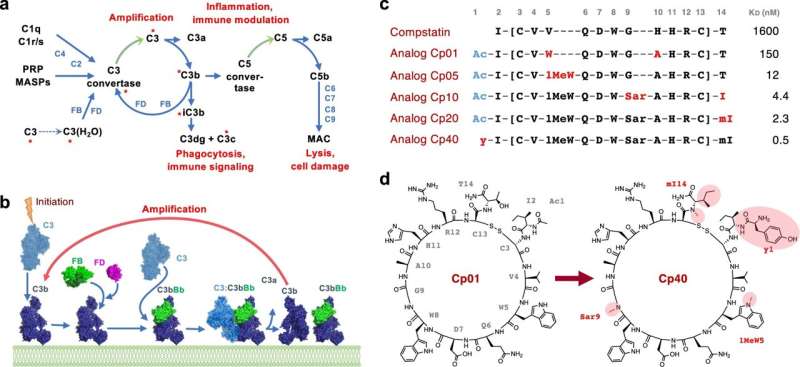How an emerging drug class dampens harmful immune reactions

The complement system defends the body against microbial intruders, but it can also attack the body’s own cells for various reasons and therefore contribute to clinical complications. These complications range from age-related and chronic inflammatory diseases such as macular degeneration to the rejection of organ transplants. In such cases, it would make sense from a medical perspective to shut the complement system down in a controlled manner with the use of drugs.
Despite the wide range of medical applications, there has long been only a single substance class of “complement inhibitors,” which are in any case only authorized for a few very rare diseases. It wasn’t until 2021 that a new therapeutic option came to the market in the form of the compstatins, a class of drugs that bring a central factor of the complement system to a standstill. The discovery and development of this substance family is rooted in research by Professor John Lambris’ group at the University of Pennsylvania.
Now, a research group led by Professor Daniel Ricklin at the University of Basel has worked with Lambris and an international team of researchers in order to study these compstatins’ mode of action in detail. Writing in the journal Nature Communications, the researchers describe how different variants of this family of active substances interact with the central factor of the complement system and how exactly they operate at the molecular level.
Optimizing active substances and facilitating research
On the one hand, the results pave the way for the further optimization of active substances in the compstatin family. “On the other hand, the findings also help us understand why compstatins have a highly specific effect on the human complement system,” Ricklin explains.
What is beneficial in therapy can prove to be a hindrance in basic research because it impedes working with model organisms. With this in mind, an interdisciplinary research project at the Department of Pharmaceutical Sciences aims to provide clinical research with new variants of the inhibitor that can help gain a better understanding of various diseases and pave the way for novel therapeutic strategies.
More information:
Christina Lamers et al, Insight into mode-of-action and structural determinants of the compstatin family of clinical complement inhibitors, Nature Communications (2022). DOI: 10.1038/s41467-022-33003-7
Journal information:
Nature Communications
Source: Read Full Article


